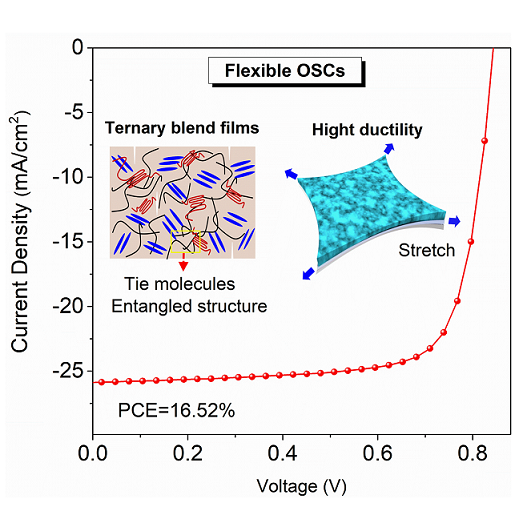A research group led by Prof. GE Ziyi at the Ningbo Institute of Materials Technology and Engineering (NIMTE) of the Chinese Academy of Sciences (CAS), has developed high-performance flexible organic solar cells (OSCs) with excellent thermal stability and stretchability, achieving power conversion efficiency (PCE) of over 16.5%. The relevant study was published in Matter.
As a promising power source for wearable electronic systems, such as electronic textiles and soft robotics, etc., flexible OSCs have attracted great attention due to their good robustness and compatibility. However, reconciling high PCE, reasonable stretchability and thermal stability in one integrated device is a grand challenge.
The researchers at NIMTE incorporated polymer guests (PY-IT) into the PM6:BTP-eC9 blend film to form entangled chain networks, thus successfully improved the ductility and morphologically stability of the PM6:BTP-eC9 blend film.
Benefiting from the effective dissipation of the local load by the entangled structure, the crack-onset strain (COS) of the developed ternary blend film has improved by 17.14% compared with the traditional binary blend film.
In addition, a stabilized PCE of 16.52% was obtained for the polyethylene terephthalate (PET)-substrate-based flexible OSCs with excellent bending tolerance, thanks to the ternary heterojunction strategy.
When stored in a N2-filled glove box at 85°C, the PCE of the inverted ternary OSCs maintained over 85.5% (~7.2% higher than the binary system) of its initial efficiency after 250 hours, indicating impressive thermal stability.
Moreover, the ternary OSCs showed excellent stretchability, which maintained PCE retention of over 88% (~13% higher than that of the binary system) after 200 stretching cycles under a tensile strain of ~5%.
This study may shed light on the development and fabrication of high-ductility flexible OSCs by virtue of the structure morphology tuning.
The work was supported by the National Science Fund for Distinguished Young Scholars (No. 21925506), National Natural Science Foundation of China (Nos. U21A20331 and 81903743), Ningbo S&T Innovation 2025 Major Special Programme (No. 2018B10055), and CAS Key Project of Frontier Science Research (No. QYZDB-SSW-SYS030), and Ningbo Natural Science Foundation (No. 2021J192).

Fig. Schematic illustration of the fracture mechanisms of ternary blend films and J–V curves of the flexible device (Image by NIMTE)
Contact
SONG Wei
Ningbo Institute of Materials Technology and Engineering
E-mail: songwei@nimte.ac.cn

